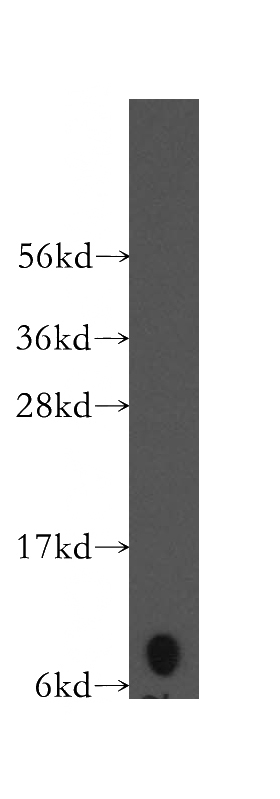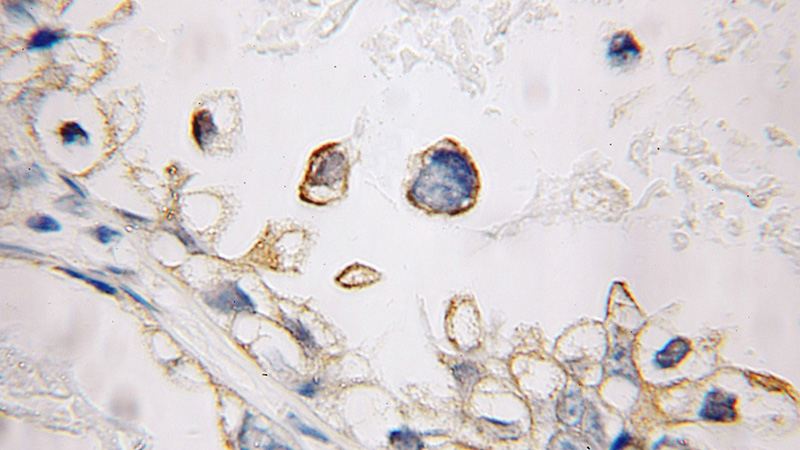-
Product Name
GRO alpha antibody
- Documents
-
Description
GRO alpha Rabbit Polyclonal antibody. Positive WB detected in COLO 320 cells, mouse small intestine tissue. Positive IHC detected in human ovary tumor tissue. Observed molecular weight by Western-blot: 8 kDa
-
Tested applications
ELISA, WB, IHC
-
Species reactivity
Human, Mouse; other species not tested.
-
Alternative names
C X C motif chemokine 1 antibody; CXCL1 antibody; FSP antibody; GRO antibody; GRO alpha(1 73) antibody; GRO1 antibody; GROa antibody; Growth regulated alpha protein antibody; MGSA antibody; MGSA a antibody; NAP 3 antibody; SCYB1 antibody
-
Isotype
Rabbit IgG
-
Preparation
This antibody was obtained by immunization of GRO alpha recombinant protein (Accession Number: NM_001511). Purification method: Antigen affinity purified.
-
Clonality
Polyclonal
-
Formulation
PBS with 0.1% sodium azide and 50% glycerol pH 7.3.
-
Storage instructions
Store at -20℃. DO NOT ALIQUOT
-
Applications
Recommended Dilution:
WB: 1:500-1:5000
IHC: 1:20-1:200
-
Validations

COLO 320 cells were subjected to SDS PAGE followed by western blot with Catalog No:111217(CXCL1 antibody) at dilution of 1:300

Immunohistochemical of paraffin-embedded human ovary tumor using Catalog No:111217(CXCL1 antibody) at dilution of 1:100 (under 10x lens)
-
Background
CXCL1, also named as FSP, GRO1, GROa, MGSA, MGSA-a, NAP-3 and SCYB1, is a small cytokine belonging to the CXC chemokine family that was previously called GRO1 oncogene. It has chemotactic activity for neutrophils. CXCL1 may play a role in inflammation and exerts its effects on endothelial cells in an autocrine fashion. In vitro, the processed forms GRO-alpha(4-73), GRO-alpha(5-73) and GRO-alpha(6-73) show a 30-fold higher chemotactic activity. CXCL1 is secreted by human melanoma cells, has mitogenic properties and is implicated in melanoma pathogenesis. CXCL1 is expressed by macrophages, neutrophils and epithelial cells. CXCL1 plays a role in spinal cord development by inhibiting the migration of oligodendrocyte precursors and is involved in the processes of angiogenesis, inflammation,wound healing, and tumorigenesis.This chemokine elicits its effects by signaling through the chemokine receptor CXCR2. The gene for CXCL1 is located on human chromosome 4 amongst genes for other CXC chemokines. An initial study in mice showed evidence that CXCL1 decreased the severity of multiple sclerosis and may offer a neuro-protective function.
-
References
- Peng W, Ye Y, Rabinovich BA. Transduction of tumor-specific T cells with CXCR2 chemokine receptor improves migration to tumor and antitumor immune responses. Clinical cancer research : an official journal of the American Association for Cancer Research. 16(22):5458-68. 2010.
- Sapoznik S, Ortenberg R, Galore-Haskel G. CXCR1 as a novel target for directing reactive T cells toward melanoma: implications for adoptive cell transfer immunotherapy. Cancer immunology, immunotherapy : CII. 61(10):1833-47. 2012.
- Jiao Y, Darzi Y, Tawaratsumida K. Induction of bone loss by pathobiont-mediated Nod1 signaling in the oral cavity. Cell host & microbe. 13(5):595-601. 2013.
- Erez N, Glanz S, Raz Y, Avivi C, Barshack I. Cancer associated fibroblasts express pro-inflammatory factors in human breast and ovarian tumors. Biochemical and biophysical research communications. 437(3):397-402. 2013.
- Wu T, Du R, Hong Y, Jia L, Zeng Q, Cheng B. IL-1 alpha regulates CXCL1, CXCL10 and ICAM1 in network form in oral keratinocytes. Clinical laboratory. 59(9-10):1105-11. 2013.
- Grgic I, Hofmeister AF, Genovese G. Discovery of new glomerular disease-relevant genes by translational profiling of podocytes in vivo. Kidney international. 86(6):1116-29. 2014.
- Cao Z, Fu B, Deng B, Zeng Y, Wan X, Qu L. Overexpression of Chemokine (C-X-C) ligand 1 (CXCL1) associated with tumor progression and poor prognosis in hepatocellular carcinoma. Cancer cell international. 14(1):86. 2014.
- Yeh CY, Shun CT, Kuo YM. Activated human valvular interstitial cells sustain interleukin-17 production to recruit neutrophils in infective endocarditis. Infection and immunity. 83(6):2202-12. 2015.
Related Products / Services
Please note: All products are "FOR RESEARCH USE ONLY AND ARE NOT INTENDED FOR DIAGNOSTIC OR THERAPEUTIC USE"
